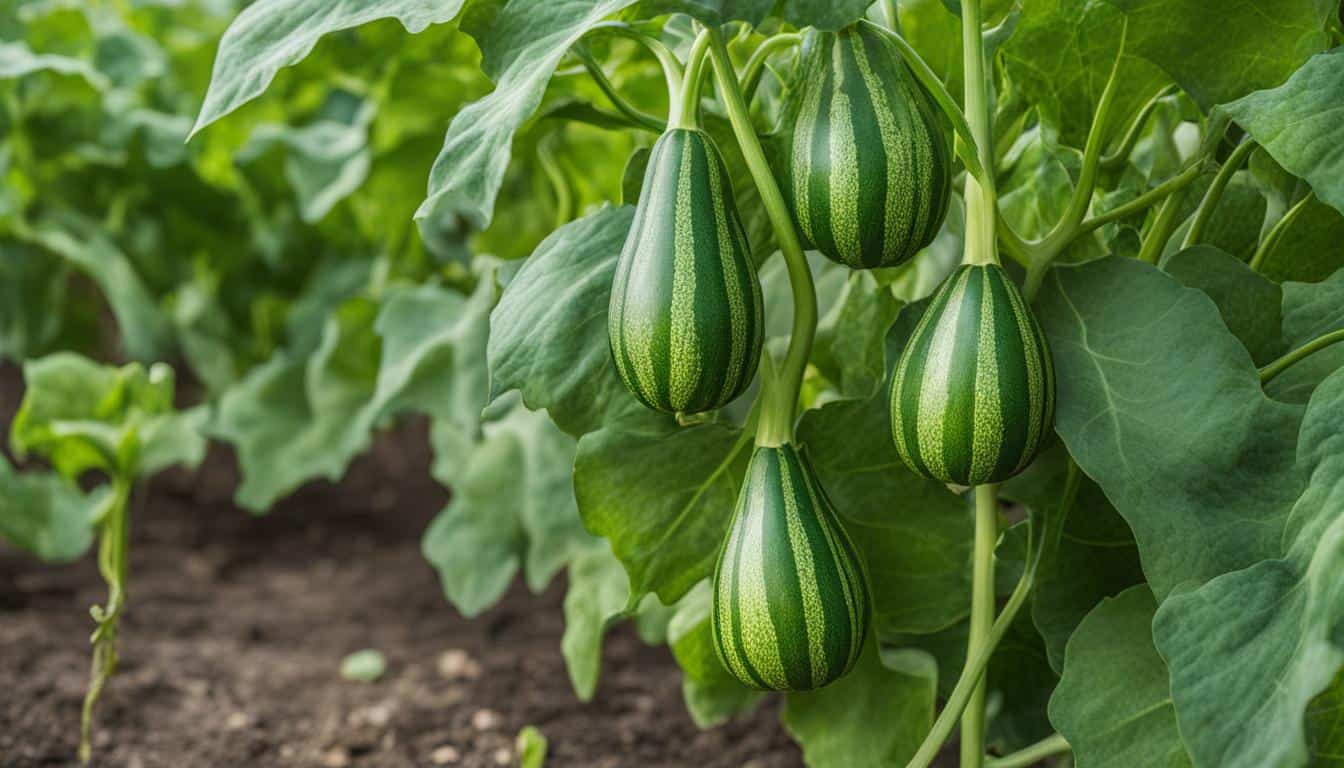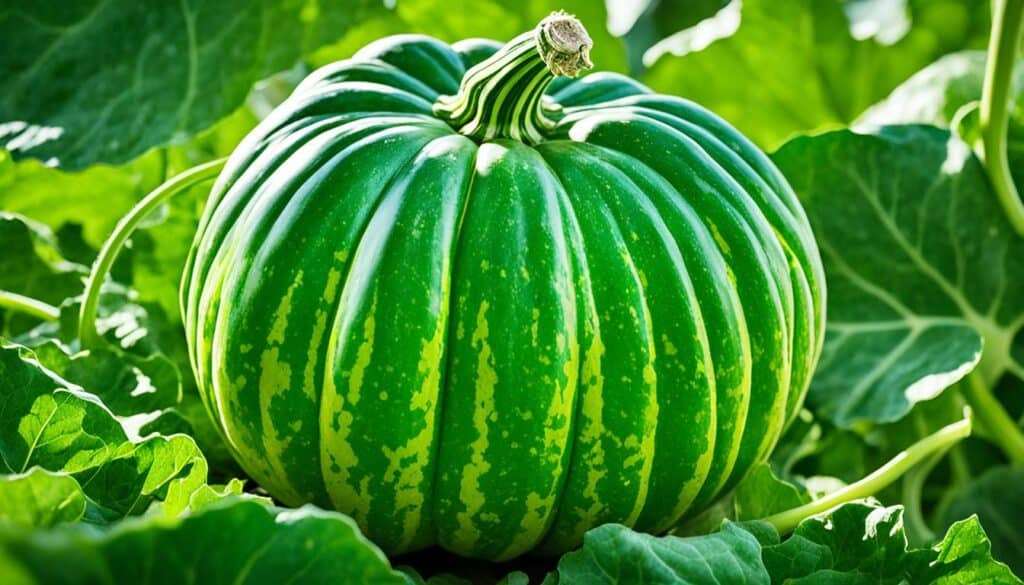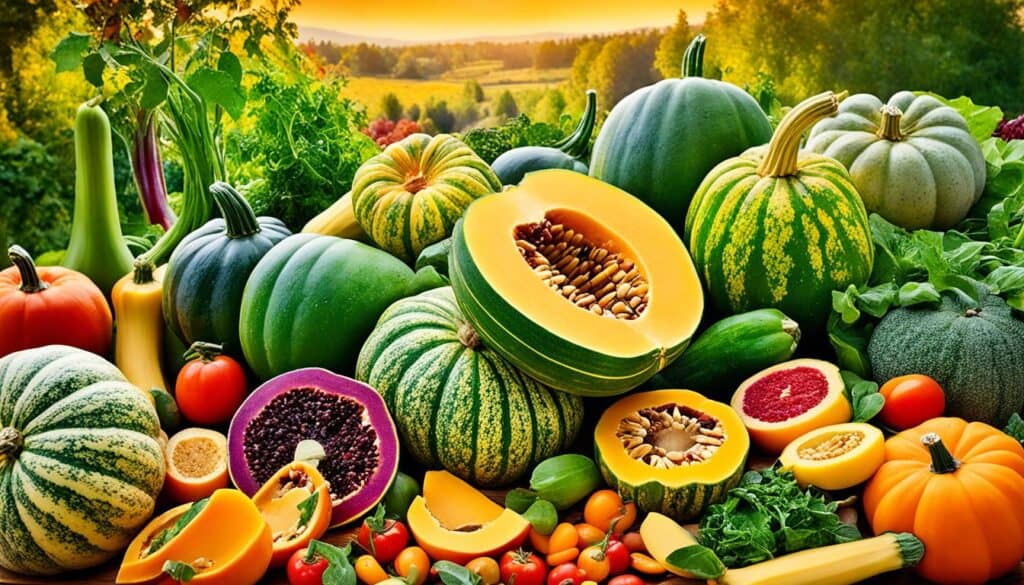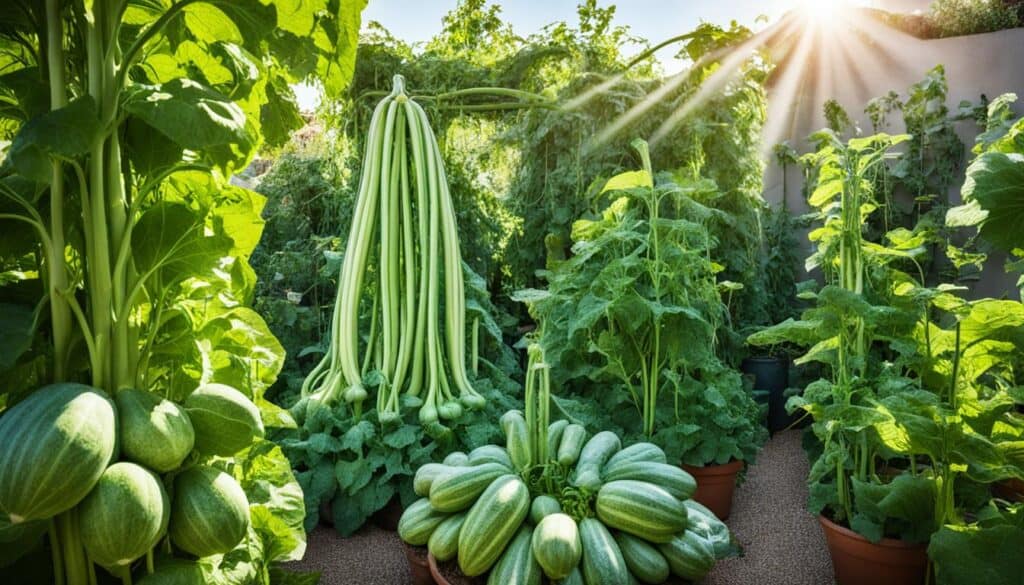Did you know that a single vine of tromboncino squash can produce up to six fruits, each weighing around 800g to 1kg? That’s an incredible yield from just one plant! If you’re looking to add a bountiful and versatile vegetable to your garden, tromboncino squash is the way to go. This climbing squash, closely related to pumpkins and courgettes, is renowned for its extraordinary fruits that can grow up to two feet long. Whether you’re a seasoned gardener or a beginner, I have some top tips to help you successfully grow tromboncino squash in your own garden.
Key Takeaways:
- Tromboncino squash can produce up to six fruits per vine, weighing around 800g to 1kg each.
- Tromboncino squash is a climbing squash, closely related to pumpkins and courgettes.
- It is a versatile and delicious vegetable that can be harvested at any size.
- Tromboncino squash is easy to grow and can be used in a variety of recipes.
- With its resistance to pests and diseases, tromboncino squash is a great addition to any garden.
Choosing the Right Soil and Sunlight for Tromboncino Squash
When it comes to growing tromboncino squash, providing the right soil and sunlight is crucial for the plant’s success. Let me share with you some tips on how to create the ideal conditions for your tromboncino squash to thrive.
Soil Requirements
Tromboncino squash plants require a rich and well-draining soil to support their vigorous growth. It is important to prepare the soil properly before planting. Here are the key steps:
- Choose a location in your garden that receives full sun. Tromboncino squash plants love sunlight and need at least six to eight hours of direct sun each day to reach their full potential.
- Prepare the soil by loosening it with a garden fork or tiller. This will enhance drainage and ensure that the roots can penetrate easily.
- Mix in plenty of compost to enrich the soil with essential nutrients. Compost will also improve the soil’s structure, water retention, and drainage.
The combination of a rich, fertile soil and good drainage will provide the perfect foundation for your tromboncino squash plants to grow healthy and strong.
Sunlight Requirements
As mentioned earlier, tromboncino squash thrives in full sun. This means that they should be planted in a location that receives direct sunlight for most of the day. Sunlight is essential for the plant’s growth, fruit development, and overall productivity.
Positioning your tromboncino squash plants in a sunny spot will maximize their exposure to sunlight, ensuring optimal photosynthesis and energy production. This, in turn, will result in robust vines, abundant foliage, and a bountiful harvest.
In conclusion, providing the right soil and sunlight is essential for growing healthy and productive tromboncino squash plants. Remember to prepare a rich and well-draining soil with plenty of compost mixed in. Additionally, make sure to plant your squash in a location that receives full sun for optimal growth. By creating these ideal conditions, you’ll be well on your way to enjoying a successful tromboncino squash harvest.
Planting and Growing Tromboncino Squash
When it comes to growing tromboncino squash, timing is everything. It’s best to plant your squash in the spring once the danger of frost has passed. This allows the plants to establish themselves and thrive in optimal growing conditions. Whether you choose to start your seeds indoors or sow them directly into the ground, it’s important to wait until the soil has warmed up before planting.
If you decide to start your seeds indoors, simply sow them in biodegradable pots filled with seed starting mix. Keep the pots in a warm location, such as a sunny windowsill or a greenhouse, until the seedlings are ready to be transplanted. This typically takes around 4-6 weeks.
Alternatively, you can sow the seeds directly into the ground once it has warmed up. Make sure to create a small mound or raised bed for the seeds, as this helps with drainage and prevents waterlogged soil. Plant the seeds about 1 inch deep and 3-4 feet apart, allowing enough space for the vines to sprawl or be trained up a trellis.
Throughout the growing season, tromboncino squash plants require regular feedings of organic fertilizer to promote healthy growth and abundant fruit production. This can be achieved by adding compost or well-rotted manure to the soil before planting and incorporating additional organic fertilizer every 4-6 weeks.
Remember, tromboncino squash is a vigorous climber, so be prepared to provide support for the vines as they grow. This can be in the form of trellises, stakes, or even a sturdy fence. Training the vines upwards not only saves space in the garden, but also improves air circulation and helps prevent diseases.
Tromboncino Squash Planting and Growing Tips:
- Plant in spring after the danger of frost has passed.
- Start seeds indoors or sow them directly into the ground.
- Wait until the soil has warmed up before planting.
- Space plants 3-4 feet apart to allow for vine growth.
- Provide regular feedings of organic fertilizer.
- Support the vines with trellises or stakes.
Expert Tip:
“For optimal growth, ensure your tromboncino squash plants receive at least 6-8 hours of direct sunlight each day. This will help the vines thrive and produce an abundant harvest.”
Harvesting Tromboncino Squash
Harvesting tromboncino squash is an exciting endeavor that allows you to enjoy the delicious fruits of your labor. The great thing about tromboncino squash is its versatility when it comes to harvesting. You can pick the fruits at different stages of maturity, tailoring your harvest to suit your preferences and culinary needs.
If you prefer a tender and mild flavor, you can harvest tromboncino squash when they are still young and green. At this stage, they can be used in various dishes just like zucchini squash. These young fruits are perfect for sautés, stir-fries, and even raw in salads, adding a delightful crunch and freshness.
However, if you desire a richer and denser texture, similar to butternut squash, you can leave the tromboncino squash to mature further. As they ripen, the fruits transition into a beautiful buttery color, indicating their readiness for harvest. These mature tromboncino squash can be roasted, baked, or even made into creamy soups, bringing a delightful nutty flavor to your recipes.
So, how do you know when to harvest your tromboncino squash? Look for visual cues that indicate the fruits are ready to be picked. The color of the squash will change from vibrant green to a more muted tone, whether it is the young or mature variety. Additionally, keep an eye on the attached vine. As the fruits reach maturity, the vine will start to brown and die back, signaling that it’s time to harvest.
Remember, tromboncino squash can be harvested at any size, depending on your personal preference. Whether you enjoy them young and tender or mature and flavorful, the choice is yours. Harvesting tromboncino squash at different stages of maturity allows you to explore a diverse range of culinary possibilities.
Pest and Disease Management for Tromboncino Squash
When growing tromboncino squash, it’s important to be aware of the potential pests and diseases that can affect your plants. By taking proactive measures and implementing effective management strategies, you can protect your crop and ensure a successful harvest.
Common Pests
Tromboncino squash is susceptible to various pests that can damage the foliage and fruits. Some common pests to watch out for include:
- Aphids
- Slugs
- Snails
- Cucumber beetles
To manage these pests, regular monitoring is essential. Inspect your plants regularly, paying close attention to the undersides of leaves where pests often hide. If you notice any infestations, there are several organic methods you can use to control them.
Pest Management Strategies
Integrated pest management (IPM) practices are highly effective in managing pests on tromboncino squash. Here are some strategies you can implement:
- Natural predators: Encourage beneficial insects such as ladybugs and lacewings, which feed on aphids and other pests. Planting flowers that attract these beneficial insects can help create a balanced ecosystem in your garden.
- Handpicking: If you spot slugs or snails, you can remove them by hand and relocate them away from your plants.
- Barriers: Use physical barriers such as row covers or copper tape to deter cucumber beetles and other crawling pests.
- Organic sprays: In severe infestations, consider using organic sprays such as insecticidal soap or neem oil. Follow the instructions on the product labels and apply them according to the recommended frequency.
Disease Management
In addition to pests, tromboncino squash can also be susceptible to diseases, with powdery mildew being a common issue. Powdery mildew appears as a white, powdery coating on the leaves and can hinder plant growth. To manage powdery mildew:
- Adequate airflow: Ensure proper spacing between plants to promote good airflow and reduce humidity levels, which can contribute to powdery mildew development.
- Proper watering: Water at the base of the plant to keep the foliage dry. Avoid overhead watering, as wet leaves can encourage the growth of powdery mildew.
- Fungicide application: If powdery mildew becomes a persistent issue, you can use fungicidal sprays that are labeled for squash plants. Follow the instructions on the product labels and apply them as directed.
It’s worth noting that disease-resistant varieties of tromboncino squash are available, which can help prevent or reduce the occurrence of certain diseases. When selecting seeds or seedlings, consider choosing varieties that are known for their disease resistance.
| Pest | Symptoms | Management |
|---|---|---|
| Aphids | Stunted growth, curled leaves, sticky residue | – Encourage natural predators – Use insecticidal soap or neem oil |
| Slugs | Holes in leaves, slime trails | – Handpick and relocate – Use copper tape or barriers |
| Snails | Holes in leaves, slime trails | – Handpick and relocate – Use copper tape or barriers |
| Cucumber beetles | Yellowing leaves, feeding damage | – Use row covers or barriers – Handpick and control larvae |
Using Tromboncino Squash in Cooking
Tromboncino squash is not only a versatile ingredient, but it also adds a unique flavor and texture to a variety of dishes. From spiralizing to roasting, this squash can be used in numerous recipes to create delicious and nutritious meals. Whether you’re looking to add a healthy twist to your favorite pasta dish or experiment with new flavors, tromboncino squash has got you covered.
Roasted Tromboncino Squash
If you want to bring out the natural sweetness of tromboncino squash, try roasting it. Simply slice the squash into thick rounds, toss them in olive oil, sprinkle with salt and pepper, and spread them out on a baking sheet. Roast in a preheated oven at 400°F for about 20-25 minutes, or until the squash is tender and golden brown. The roasted tromboncino squash can be enjoyed as a side dish or added to salads for a burst of flavor.
Tromboncino Squash Soup
During the cooler months, a warm and comforting bowl of tromboncino squash soup is the perfect choice. Start by sautéing onions and garlic in a large pot, then add diced tromboncino squash, vegetable broth, and your choice of herbs and spices. Simmer until the squash is tender, then use an immersion blender or a countertop blender to puree the soup until smooth. Finish with a swirl of cream or a sprinkle of fresh herbs for an elegant presentation.
Tromboncino Squash Pasta
If you’re a fan of zucchini noodles, you’re going to love tromboncino squash pasta. Use a spiralizer or a julienne peeler to create long, thin strands of squash. Sauté the noodles in a pan with olive oil and garlic until just tender. Top with your favorite pasta sauce, sprinkle with parmesan cheese, and you’ve got a healthy and satisfying alternative to traditional pasta.
“Tromboncino squash adds a delightful twist to classic recipes. Its mild flavor and firm texture make it a versatile ingredient that can be used in various dishes. From soups to stir-fries, this squash is a true culinary gem.”
Stuffed Tromboncino Squash Flowers
Don’t forget to take advantage of the beautiful flowers that tromboncino squash plants produce. Male flowers can be harvested and stuffed for a unique appetizer. Mix together a flavorful filling of cheese, herbs, and spices, gently stuff the flowers, and dip them in a light batter. Fry until golden brown and crispy for a delightful and visually stunning addition to your meal.
As you can see, tromboncino squash offers endless possibilities in the kitchen. Its versatility allows you to get creative and explore new flavors. So go ahead and experiment with this delicious and nutritious squash. Your taste buds will thank you!
Tromboncino Squash Varieties
While tromboncino squash is the most common variety, there are other cultivars available, each with its own unique characteristics. Some varieties may have different flavors or colors, so it can be interesting to experiment with different types in your garden.
If you’re a passionate gardener like me, you’ll find joy in exploring the diverse world of tromboncino squash varieties. These unique cultivars offer a range of flavors, textures, and colors, adding excitement and variety to your garden and kitchen.
Here are a few tromboncino squash varieties to consider:
- Tromboncino Nero: This variety features dark green skin and a rich, nutty flavor. It can be harvested at various stages, from tender and mild in its early stages to dense and flavorful when fully mature.
- Tromboncino Bianco: With its pale green skin and delicate flavor, this variety is perfect for adding a subtle touch to your favorite dishes. Its flesh has a creamy texture that melts in your mouth.
- Tromboncino Giallo: This vibrant yellow variety adds a burst of color to your garden and palate. Its sweet, buttery flavor complements a wide range of recipes, from roasted vegetables to pasta dishes.
Remember, every variety of tromboncino squash brings its own unique qualities to the table. Consider growing a few different varieties to explore their flavors and adaptability in various recipes.
Whether you’re a seasoned gardener or just starting out, experimenting with different tromboncino squash varieties can be an exciting and rewarding experience. So, go ahead and explore the world of tromboncino squash to discover your favorite flavors and make your garden truly exceptional.
Health Benefits of Tromboncino Squash
Tromboncino squash is not only delicious but also offers numerous health benefits. This versatile vegetable is a great addition to any diet and provides essential nutrients to support overall well-being.
Here are some key health benefits of tromboncino squash:
- Low in Calories and Fat: Tromboncino squash is a low-calorie and low-fat vegetable, making it an excellent choice for weight management and maintaining a healthy diet.
- High in Fiber: The high fiber content in tromboncino squash contributes to digestive health, aids in regular bowel movements, and helps control blood sugar levels.
- Rich in Vitamins A and C: Tromboncino squash is a good source of vitamins A and C, which are essential for immune function, vision health, and skin health.
- Contains Essential Minerals: This squash variety contains important minerals such as potassium and manganese, which play a vital role in maintaining electrolyte balance, supporting bone health, and promoting optimal muscle function.
Including tromboncino squash in your diet can help you meet your daily nutrient requirements and contribute to a well-rounded, healthy lifestyle.
“Tromboncino squash is not only delicious but also offers numerous health benefits. This versatile vegetable is a great addition to any diet and provides essential nutrients to support overall well-being.”
Why Choose Tromboncino Squash for Your Garden
Tromboncino squash is a great addition to any garden for several reasons. Its versatility and ease of cultivation make it a favorite among gardeners of all skill levels. Whether you are an experienced gardener or a beginner, tromboncino squash is a fantastic choice for your garden.
Easy to Grow
Growing tromboncino squash is a breeze, even for beginners. It is a hardy plant that thrives in most garden environments. With a little care and attention, you’ll be rewarded with a generous harvest of delicious squash.
Abundant Harvest
One of the main reasons to choose tromboncino squash for your garden is its ability to produce a copious amount of fruits. Each vine can yield multiple squashes, ensuring you have plenty to enjoy throughout the growing season.
Versatile in the Kitchen
Tromboncino squash is incredibly versatile when it comes to cooking. You can use it in a wide range of recipes, from soups and stir-fries to salads and pasta dishes. Its mild flavor and tender texture make it a delicious addition to any meal.
Visually Appealing
With its climbing growth habit, tromboncino squash adds a touch of visual interest to your garden. As the vines grow and intertwine, they create a stunning backdrop for other plants and can be trained to climb trellises or fences. Its vibrant green color and unique elongated shape make it a standout feature in any garden.
Resistant to Pests
Unlike other types of summer squash, tromboncino squash is resistant to squash vine borers, a common garden pest. This resistance means that your plants are less likely to be attacked and damaged, resulting in a healthier and more productive garden.
| Reasons to Choose Tromboncino Squash for Your Garden |
|---|
| Easy to grow |
| Abundant harvest |
| Versatile in the kitchen |
| Visually appealing |
| Resistant to pests |
With all these benefits, it’s no wonder that tromboncino squash is a popular choice for gardeners. Whether you’re a seasoned pro or just starting out, adding tromboncino squash to your garden will bring you joy and satisfaction as you watch it flourish and provide you with a harvest of delicious and nutritious squash.
Tips for Successful Tromboncino Squash Cultivation
When it comes to cultivating tromboncino squash, there are a few key tips that can help ensure a successful harvest. From providing proper support for the vine to managing pests and diseases, these practices will set you up for a bountiful crop of this delicious and versatile squash.
1. Provide Adequate Support
Tromboncino squash is a vigorous climber, so it’s important to provide adequate support for the vine. Whether you choose to trellis the plant or allow it to ramble over the ground, providing support will help prevent the fruits from rotting and keep them off the soil, reducing the risk of pests and diseases.
2. Regular Watering
Consistent and regular watering is crucial for the successful cultivation of tromboncino squash. These plants have deep, extensive root systems, so it’s important to water deeply to ensure the moisture reaches the roots. Avoid over-watering, as excessive moisture can lead to root rot.
3. Fertilize Wisely
Fertilization is key to providing the nutrients that tromboncino squash plants need for healthy growth. When choosing a fertilizer, opt for a balanced organic fertilizer that is high in nitrogen, phosphorus, and potassium. Apply the fertilizer according to the manufacturer’s instructions and remember to water the plants immediately after application to prevent damage to the roots.
4. Pest and Disease Management
Tromboncino squash, like other plants, can be susceptible to pests and diseases. Regularly inspect your plants for common pests such as aphids, cucumber beetles, and squash bugs. If you notice any signs of infestation, take immediate action to control the pests. Similarly, preventive measures such as using row covers and practicing crop rotation can help minimize the risk of diseases like powdery mildew.
| Pest or Disease | Management |
|---|---|
| Aphids | Introduce beneficial insects like ladybugs or use insecticidal soap. |
| Cucumber Beetles | Use row covers and handpick the beetles. |
| Powdery Mildew | Apply a fungicidal spray according to the manufacturer’s instructions. |
5. Regular Harvesting
To encourage continuous fruit production, it’s important to regularly harvest tromboncino squash when they reach the desired size. Young, tender tromboncino squash can be harvested when they are around 6-8 inches in length, while larger fruits can be left to ripen and become denser in texture. Harvesting regularly will also help prevent the plant from focusing its energy on mature fruits, leading to an increased yield.
By following these tips for successful tromboncino squash cultivation, you can enjoy a plentiful harvest of this delicious and versatile squash. With proper support, regular watering, appropriate fertilization, and effective pest and disease management, your tromboncino squash plants will thrive, providing you with a bounty of fresh and flavorful fruits.
Why Tromboncino Squash is the Perfect Garden Gem
Tromboncino squash is truly a garden gem. Its versatility in the kitchen, nutritional value, and ease of cultivation make it a perfect addition to any garden. Whether you’re a seasoned gardener or a beginner, growing tromboncino squash can be a rewarding and delicious experience.
When it comes to the garden, tromboncino squash is a dream. It is a vigorous and robust plant that adapts well to various growing conditions and climates. Whether you have a small backyard or a spacious garden, tromboncino squash will thrive and produce an abundant harvest.
One of the greatest advantages of tromboncino squash is its climbing growth habit. This means that it can be trained to grow vertically by using trellises or other forms of support. By utilizing vertical space, you can maximize your garden’s productivity and save valuable ground space for other crops.
In the kitchen, tromboncino squash is a versatile ingredient that can be used in a multitude of recipes. Its mild and slightly sweet flavor pairs well with a variety of dishes, making it a perfect addition to salads, stir-fries, soups, and more. From crispy fries to creamy pasta, the possibilities are endless.
Besides being delicious, tromboncino squash is also highly nutritious. It is low in calories and rich in dietary fiber, vitamins, and minerals. This versatile vegetable is a good source of vitamins A and C, essential for a healthy immune system, as well as potassium and manganese, which support proper bodily functions.
“Tromboncino squash is not only a delight to grow but also a treasure trove of culinary possibilities. Its tender flesh and delicate flavor make it a perfect ingredient for both savory and sweet dishes.” – Chef Sandra Roberts
Whether you’re looking to add more variety to your garden, boost your culinary skills, or enhance your nutrient intake, tromboncino squash is the perfect choice. It’s a garden gem that offers endless possibilities and rewards. Don’t miss out on the opportunity to grow this versatile and nutritious vegetable in your own garden.
Health Benefits of Tromboncino Squash:
- Low in calories and fat
- High in dietary fiber
- Good source of vitamins A and C
- Rich in potassium and manganese
Experience the joys of growing tromboncino squash and enjoy the perfect combination of garden beauty, culinary delight, and nutritional goodness.
How Tromboncino Squash Compares to Other Squash Varieties
| Squash Variety | Flavor | Texture | Nutritional Content |
|---|---|---|---|
| Tromboncino Squash | Mildly sweet | Delicate and tender | Low in calories, high in fiber, vitamins A and C, potassium, and manganese |
| Zucchini | Mild and slightly nutty | Crisp and firm | Low in calories, moderate in fiber, vitamins A and C, potassium, and manganese |
| Butternut Squash | Sweet and nutty | Creamy and dense | Low in calories, high in fiber, vitamins A and C, potassium, and manganese |
| Acorn Squash | Subtle and slightly sweet | Smooth and creamy | Low in calories, moderate in fiber, vitamins A and C, potassium, and manganese |
Note: Nutritional content may vary depending on the specific variety and cooking method.
Conclusion
Growing tromboncino squash offers a unique and enjoyable gardening experience. From planting and caring for the vines to harvesting and cooking the tender fruits, this versatile and delicious vegetable is sure to delight. With its resistance to squash vine borers and abundance of flavorsome options in the kitchen, tromboncino squash is a wonderful choice for any garden. Start growing your own tromboncino squash today and unlock the potential of this garden gem!










Leave a Reply